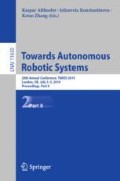Abstract
Robots are increasingly used in different scenarios, depending on the development of their capabilities and performance. The accelerating growth of robotics applications requires a tool that can comprehensively capture a wide range of robot capabilities. In this study, we evaluate robot capabilities using a structure known as “Towards Robot Characterization” (ToRCH) recently developed to meet this need. This structure defines robot capabilities and consequently enables capabilities and applications to be mapped against each other. An experiment was conducted to obtain the capabilities of two scenarios presented by the NAO robot. The method used to capture the capabilities was performed via the ToRCH structure. ToRCH implicitly illustrates the scenarios in a simple capability profile. This research assesses two aspects of the ToRCH capabilities capturing process. First, it verifies the moderate agreement level among roboticists in using ToRCH to capture the robot’s capabilities. Second, it demonstrates the richness of the ToRCH structure for capturing robot capabilities compared to the Multi-Annual Roadmap (MAR) levels. This initial study evaluates the ToRCH method in extracting different capability levels and illustrating them in a robot capability profile. It therefore highlights the potential of ToRCH in classifying robots.
Access this chapter
Tax calculation will be finalised at checkout
Purchases are for personal use only
References
Anzalone, S.M., Boucenna, S., Ivaldi, S., Chetouani, M.: Evaluating the engagement with social robots. Int. J. Soc. Robot. 7(4), 465–478 (2015)
Bhatnagar, S., et al.: Mapping intelligence: requirements and possibilities. In: Müller, V.C. (ed.) PT-AI 2017. SAPERE, vol. 44, pp. 117–135. Springer, Cham (2018). https://doi.org/10.1007/978-3-319-96448-5_13
Bonsignorio, F., Del Pobil, A.P., Messina, E.: Fostering progress in performance evaluation and benchmarking of robotic and automation systems [tc spotlight]. IEEE Robot. Autom. Mag. 21(1), 22–25 (2014)
Dobra, A.: General classification of robots. size criteria. In: Proceedings of 23rd International Conference on Robotics in Alpe-Adria-Danube Region (RAAD), pp. 1–6. IEEE (2014)
Gouaillier, D., et al.: Mechatronic design of NAO humanoid. In: 2009 IEEE International Conference on Robotics and Automation, pp. 769–774, May 2009
Landis, J.R., Koch, G.G.: The measurement of observer agreement for categorical data. Biometrics 33, 159–174 (1977)
Lee, J., Kim, D., Ryoo, H.Y., Shin, B.S.: Sustainable wearables: wearable technology for enhancing the quality of human life. Sustainability 8(5), 466 (2016)
Lenzi, T., et al.: Measuring human-robot interaction on wearable robots: a distributed approach. Mechatronics 21(6), 1123–1131 (2011)
Linjawi, M., Moore, R.K.: Towards a comprehensive taxonomy for characterizing robots. In: Giuliani, M., Assaf, T., Giannaccini, M.E. (eds.) TAROS 2018. LNCS (LNAI), vol. 10965, pp. 381–392. Springer, Cham (2018). https://doi.org/10.1007/978-3-319-96728-8_32
Rastic-Dulborough, O.: Internet of things (IoT) and human computer interaction. Technical report, University of Southampton (2014)
Interrater reliability. J. Consum. Psychol. 10(1&2), 71–73 (2001)
Siciliano, B., Khatib, O.: Springer Handbook of Robotics. Springer, Heidelberg (2016). https://doi.org/10.1007/978-3-540-30301-5
SPARC Robotics, eu-Robotics AISBL, Brussels, Belgium: Robotics Multi-Annual Roadmap for Robotics in Europe, Horizon 2020 (2016)
Stead, L., Goulev, P., Evans, C., Mamdani, E.: The emotional wardrobe. Pers. Ubiquit. Comput. 8(3–4), 282–290 (2004)
Winfield, A.: Robotics: A Very Short Introduction. Oxford University Press, Oxford (2012)
Winfield, A.F.T.: How intelligent is your intelligent robot? (2017). arxiv:1712.08878
Yousef, H., Boukallel, M., Althoefer, K.: Tactile sensing for dexterous in-hand manipulation in robotics-a review. Sens. Actuators, A 167(2), 171–187 (2011)
Author information
Authors and Affiliations
Corresponding author
Editor information
Editors and Affiliations
Rights and permissions
Copyright information
© 2019 Springer Nature Switzerland AG
About this paper
Cite this paper
Linjawi, M., Moore, R.K. (2019). Evaluating ToRCH Structure for Characterizing Robots. In: Althoefer, K., Konstantinova, J., Zhang, K. (eds) Towards Autonomous Robotic Systems. TAROS 2019. Lecture Notes in Computer Science(), vol 11650. Springer, Cham. https://doi.org/10.1007/978-3-030-25332-5_28
Download citation
DOI: https://doi.org/10.1007/978-3-030-25332-5_28
Published:
Publisher Name: Springer, Cham
Print ISBN: 978-3-030-25331-8
Online ISBN: 978-3-030-25332-5
eBook Packages: Computer ScienceComputer Science (R0)

